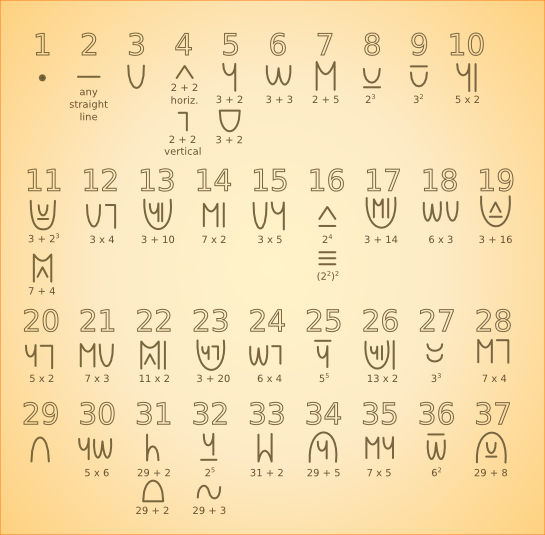I don't know why but whenever I'm bored I find myself coming up with systems of numerals. I like to set a few base shapes and combine these to make larger numbers. I like the challenge of representing large numbers in this way without it getting too messy. I posted one system like this five years ago (holy balls!)
here but that was very limited, I think this one is much better.
I wanted to base the system on prime numbers -- this makes sense if I'm constructing other numbers from a base set -- and I also wanted an algebraic feel to it.

(Image created in Inkscape: very nice program that makes precise vector graphics easy.)
The Three Basic Methods of Operation
1. Multiplication - Unconnected symbols placed side-by-side are multiplied together.
2. Exponentiation - When one symbol is above another the bottom symbol is raised to the power of the top symbol.
3. Addition - Symbols that are combined are added together and treated as a single symbol. Symbols can be combined in two ways: either by joining the symbols together or placing one inside the other. See below for detailed rules on combining symbols.
Four is shown as the sum of two lines but can also be made using the other operations: "||" (2 x 2) or "=" (2 squared). Most numbers can be written in a variety of ways, but I have tried to only show the most efficient forms.
Rules for Combining Symbols
Some of these rules may seem odd but they are in place to maintain readability.
* Only unambiguous connections are valid: the direction of the first symbol approaching the join must be different (by at least 90 degrees) to the direction of the second symbol leaving the join. For example: five can be constructed by placing an upward curve at the top of a vertical line or by crossing the top of the curve with a horizontal line. joining the curve to the bottom of the line would be invalid as the curve leads into the line (or vice versa). Note that this rule only applies when using lines, there is no ambiguity when combining curves -- such as ~ (conjoined upward and downward curves representing 32) where one curve leads into the other -- so these combinations are valid.
* The maximum width of any combined symbol is two symbols, with vertical lines treated as half-symbols.
* Vessels are symbols that can accommodate other symbols or expressions, these include curves and combined symbols where the extremities form the boundary of an enclosed space. For example, the M-shaped form of 7 can hold a symbol or expression between its legs, however, the curve of the M cannot hold a symbol or expression because the vertical lines are outside the curve (the curve is not the extremity of the symbol). Whereas the curve in the vesseled form of 5 is valid as the horizontal line is within the curve.
It's looking pretty good so far, there are only two numbers that I think look a little messy (22 and 26). I could have introduced the second curve earlier (eg for 19) but I wanted to save it for 29 as it has a neighbouring prime only two away; that means I can simply add a line to the curve to make an h symbol for 31.
I like the way curves act as natural brackets, that was a nice coincidence. I'm not sure how high this can go but I'd hope it can get to at least 100 without introducing another curve.
Shh... you're pretty.
